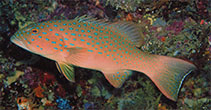| Family: |
Epinephelidae (Groupers) |
| Max. size: |
125 cm TL (male/unsexed); max.weight: 25 kg |
| Environment: |
reef-associated; marine; depth range 5 - 100 m |
| Distribution: |
Western Pacific: Thailand, Singapore, Philippines, Indonesia, Papua New Guinea, the Arafura Sea (Ref. 9819), Solomon Islands, and Australia (from Houtman Abrolhos in Western Australia to Gladstone, Queensland) (Ref. 3150). This species was formerly listed as occurring in the western Indian Ocean based on a misidentification of Plectropomus pessuliferus. |
| Diagnosis: |
Dorsal spines (total): 7-8; Dorsal soft rays (total): 10-12; Anal spines: 3-3; Anal soft rays: 8-8. Description: Characterized by red, pale grey or olive to dark brown color; head, body and fins with numerous small blue spots; small juveniles (under 5 cm) grey brown on back with scattered dark spots, broad, white midlateral stripe from upper pectoral base to basal portion of caudal fin, pair of dark stripes on central portion of caudal fin; front of jaws with pair of large canine teeth; 1-4 canines on side of lower jaw; body elongate, greatest depth 2.9-3.9 in SL; emarginate caudal fin; pectoral fins 1.8-2.2 in head length; pelvic fins 1.7-2.1 in head length (Ref. 90102). |
| Biology: |
Found in protected coastal reef in mixed algae and coral habitat (Ref. 48635). Common on inshore coastal reefs but absent in clear offshore reefs (Ref. 9710). Juveniles have a demersal existence in shallow water in reef habitats, especially around coral rubble (Ref. 27259). Migrate over short distances to spawn, forming aggregations (Ref. 6390). May move into shallow water to feed (Ref. 6390). Eggs float just below the water surface (Ref. 6390). Pelagic larvae are found in habitats similar to those of the adults (Ref. 27260). Juveniles feed on small fish and invertebrates such as crustaceans and squid (Ref. 27261). Commonly used for food. Its flesh is delicate and well appreciated (Ref. 5503). Solitary (Ref 90102). |
| IUCN Red List Status: |
Least Concern (LC); Date assessed: 29 January 2018 Ref. (130435)
|
| Threat to humans: |
reports of ciguatera poisoning |
Source and more info: www.fishbase.org. For personal, classroom, and other internal use only. Not for publication.

